NUR250: Care Plan for Miss Violet Paterson - Medical Surgical Nursing
VerifiedAdded on 2023/01/17
|9
|3064
|62
Report
AI Summary
This report presents a comprehensive nursing care plan for Miss Violet Paterson, a 77-year-old patient admitted with Acute Myocardial Infarction (AMI) and a history of osteoarthritis. The care plan addresses various aspects of her holistic needs, including initial considerations of her living situation and osteoarthritis, nursing assessments focusing on pain, fall risk, and cardiac condition. The report details care planning strategies aimed at reducing fall risk, managing joint pain through pharmacological and non-pharmacological interventions, and ensuring proper medication management. Patient education is emphasized, focusing on medication management and healthy aging, delivered using a creative approach. Finally, the plan highlights the importance of team care, involving allied healthcare professionals like occupational therapists, physiotherapists, and nutritionists to optimize her care and promote healthy aging.
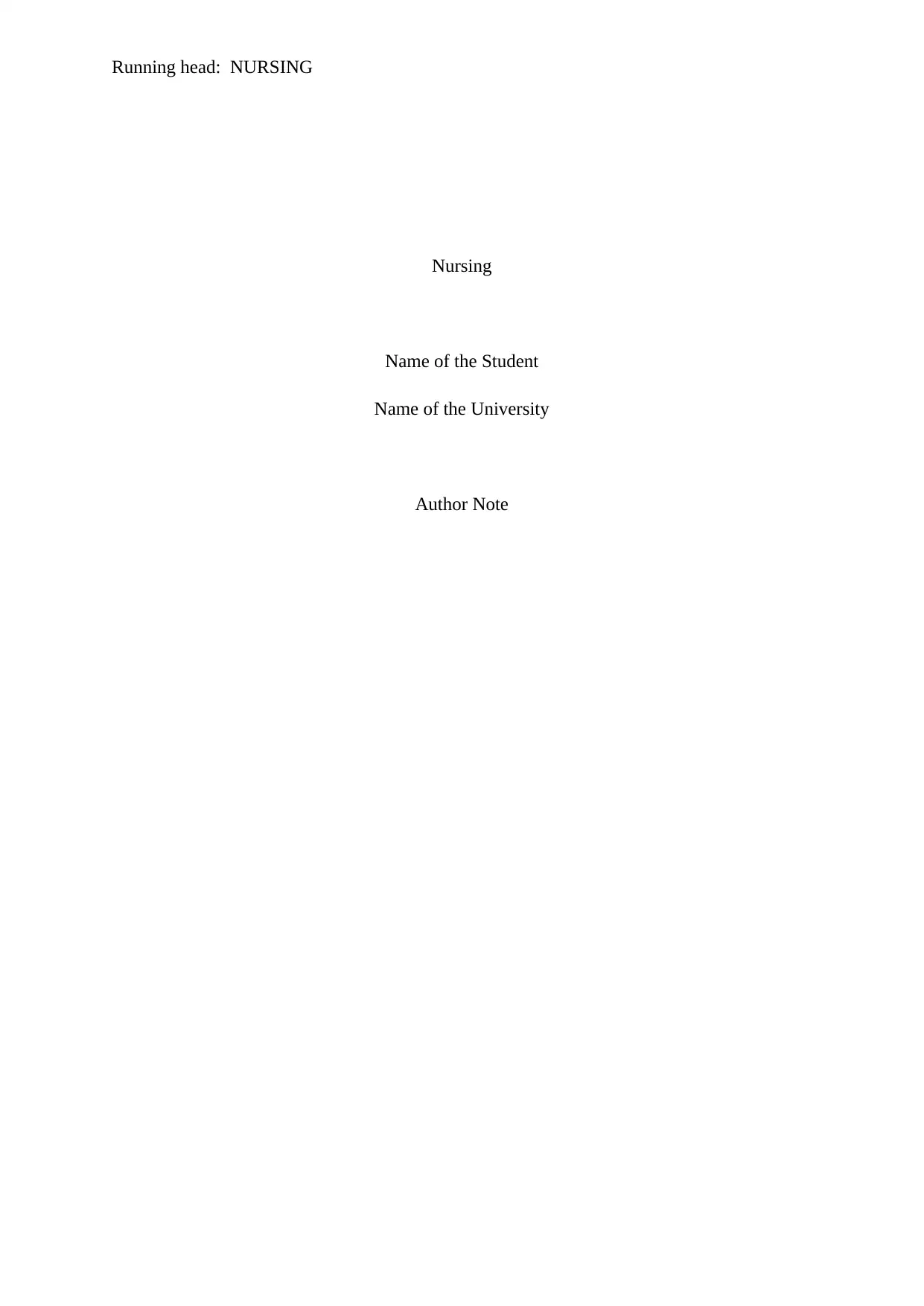
Running head: NURSING
Nursing
Name of the Student
Name of the University
Author Note
Nursing
Name of the Student
Name of the University
Author Note
Paraphrase This Document
Need a fresh take? Get an instant paraphrase of this document with our AI Paraphraser

1
NURSING
Task 1: Consider the patient
While preparing care plan for Miss Violet Paterson the first thing that must be taken
under consideration is her osteoarthritis and her residence that is located in third floor that has
no access to lift. So while preparing the care plan for Miss Violet Paterson, importance must
be given for the arrangements of the home help in order to conduct outdoor activities like
grocery shopping. Moreover, since Miss Violet Paterson is experiencing problem in
conducting her daily living activities use of aged care services in order to ascertain healthy
living while at home can also be considered. The home help or a residential care nurse will
help Miss Violet Paterson to accomplish her daily living activities like bathing or showering,
meal preparation, changing or dressing, walking or going to washroom and other
maintenance of basic health and hygiene. Miss Violet Paterson has no extended family and
her only companion is cat so a daily help who is trained in managing pets must also be
appointment. Hodgson et al. (2015) reported that ensuring proper health and well-being of the
pets helps in improving the mental health of owner. Miss Paterson also has hypertension and
was admitted with Acute Myocardial Infarction (AMI). So weekly checking of the vital signs
under the assistance of the local community health nurses must also be taken under
considerations in order to avoid the unwanted medical emergencies. The implementation of
telemedicine under the supervision of trained triage nurses might be helpful to reduce
unwanted hospitalization. While arranging home help and other residential care nurses in
order to assist activities of daily living (ADLs) of Miss Violet Paterson, assistance will be
taken from the Commonwealth Home Support Programme by the Aging and Aged Care
Service by the Australian Government (Australian Government Department of Health, 2019).
This is an Australian government subsidised program will be to provide cost-effective and
reliable solution to Miss Violet Paterson.
Task 2: Nursing assessments
Nursing Assessment 1: Assessment of Pain
According to Katz et al. (2018), older adults who are suffering from osteoarthritis
(OA) described pain as the significant symptom of OA. In spite of having an advance therapy
and interventions for OA, older adults continue to have significant sensation of pain in the
joint. Analysis of the level or the severity of pain among the older adults with OA will help in
the procurement of the patient-centered care plan. Miss Violet Paterson is 77-year old and is
NURSING
Task 1: Consider the patient
While preparing care plan for Miss Violet Paterson the first thing that must be taken
under consideration is her osteoarthritis and her residence that is located in third floor that has
no access to lift. So while preparing the care plan for Miss Violet Paterson, importance must
be given for the arrangements of the home help in order to conduct outdoor activities like
grocery shopping. Moreover, since Miss Violet Paterson is experiencing problem in
conducting her daily living activities use of aged care services in order to ascertain healthy
living while at home can also be considered. The home help or a residential care nurse will
help Miss Violet Paterson to accomplish her daily living activities like bathing or showering,
meal preparation, changing or dressing, walking or going to washroom and other
maintenance of basic health and hygiene. Miss Violet Paterson has no extended family and
her only companion is cat so a daily help who is trained in managing pets must also be
appointment. Hodgson et al. (2015) reported that ensuring proper health and well-being of the
pets helps in improving the mental health of owner. Miss Paterson also has hypertension and
was admitted with Acute Myocardial Infarction (AMI). So weekly checking of the vital signs
under the assistance of the local community health nurses must also be taken under
considerations in order to avoid the unwanted medical emergencies. The implementation of
telemedicine under the supervision of trained triage nurses might be helpful to reduce
unwanted hospitalization. While arranging home help and other residential care nurses in
order to assist activities of daily living (ADLs) of Miss Violet Paterson, assistance will be
taken from the Commonwealth Home Support Programme by the Aging and Aged Care
Service by the Australian Government (Australian Government Department of Health, 2019).
This is an Australian government subsidised program will be to provide cost-effective and
reliable solution to Miss Violet Paterson.
Task 2: Nursing assessments
Nursing Assessment 1: Assessment of Pain
According to Katz et al. (2018), older adults who are suffering from osteoarthritis
(OA) described pain as the significant symptom of OA. In spite of having an advance therapy
and interventions for OA, older adults continue to have significant sensation of pain in the
joint. Analysis of the level or the severity of pain among the older adults with OA will help in
the procurement of the patient-centered care plan. Miss Violet Paterson is 77-year old and is
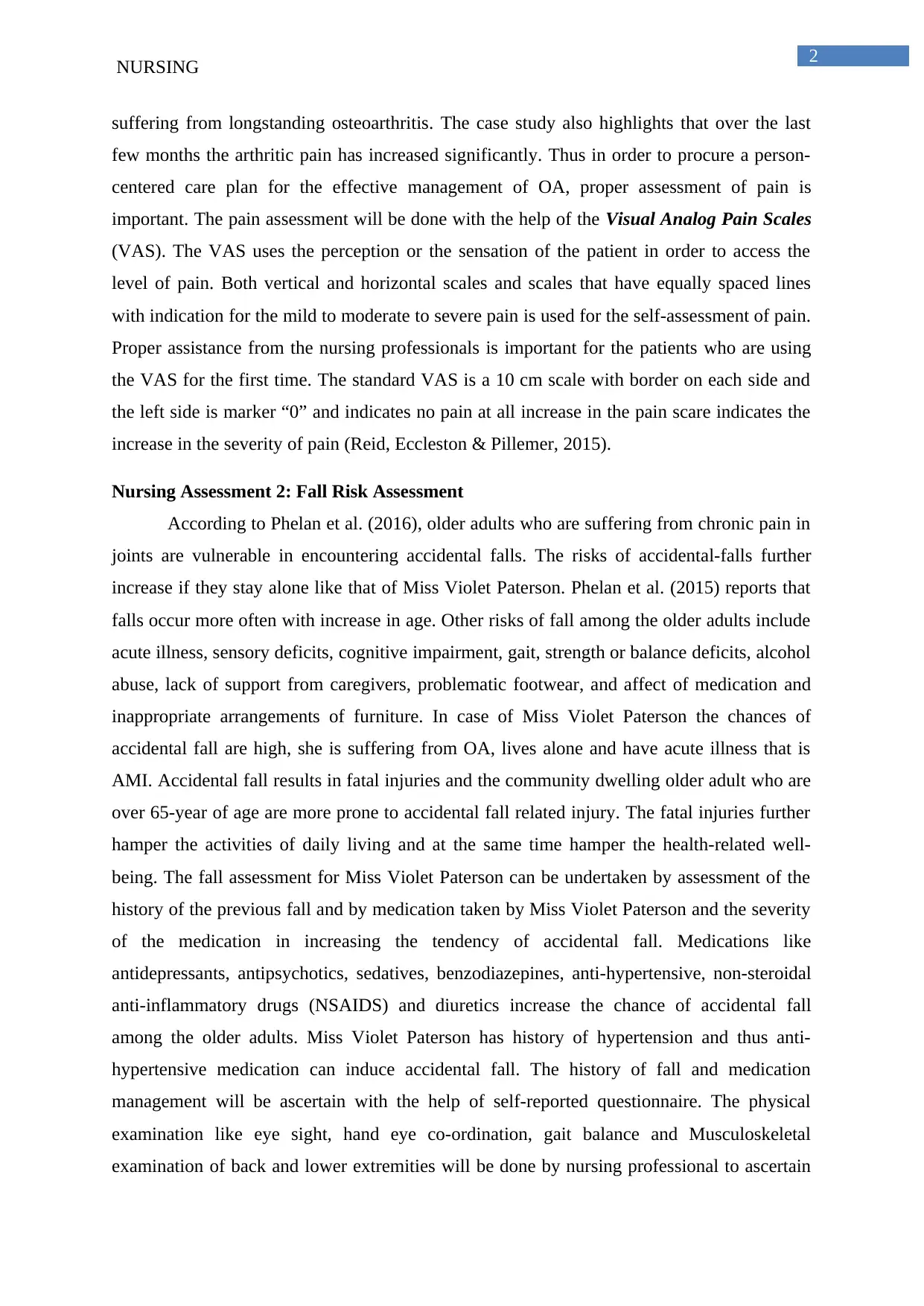
2
NURSING
suffering from longstanding osteoarthritis. The case study also highlights that over the last
few months the arthritic pain has increased significantly. Thus in order to procure a person-
centered care plan for the effective management of OA, proper assessment of pain is
important. The pain assessment will be done with the help of the Visual Analog Pain Scales
(VAS). The VAS uses the perception or the sensation of the patient in order to access the
level of pain. Both vertical and horizontal scales and scales that have equally spaced lines
with indication for the mild to moderate to severe pain is used for the self-assessment of pain.
Proper assistance from the nursing professionals is important for the patients who are using
the VAS for the first time. The standard VAS is a 10 cm scale with border on each side and
the left side is marker “0” and indicates no pain at all increase in the pain scare indicates the
increase in the severity of pain (Reid, Eccleston & Pillemer, 2015).
Nursing Assessment 2: Fall Risk Assessment
According to Phelan et al. (2016), older adults who are suffering from chronic pain in
joints are vulnerable in encountering accidental falls. The risks of accidental-falls further
increase if they stay alone like that of Miss Violet Paterson. Phelan et al. (2015) reports that
falls occur more often with increase in age. Other risks of fall among the older adults include
acute illness, sensory deficits, cognitive impairment, gait, strength or balance deficits, alcohol
abuse, lack of support from caregivers, problematic footwear, and affect of medication and
inappropriate arrangements of furniture. In case of Miss Violet Paterson the chances of
accidental fall are high, she is suffering from OA, lives alone and have acute illness that is
AMI. Accidental fall results in fatal injuries and the community dwelling older adult who are
over 65-year of age are more prone to accidental fall related injury. The fatal injuries further
hamper the activities of daily living and at the same time hamper the health-related well-
being. The fall assessment for Miss Violet Paterson can be undertaken by assessment of the
history of the previous fall and by medication taken by Miss Violet Paterson and the severity
of the medication in increasing the tendency of accidental fall. Medications like
antidepressants, antipsychotics, sedatives, benzodiazepines, anti-hypertensive, non-steroidal
anti-inflammatory drugs (NSAIDS) and diuretics increase the chance of accidental fall
among the older adults. Miss Violet Paterson has history of hypertension and thus anti-
hypertensive medication can induce accidental fall. The history of fall and medication
management will be ascertain with the help of self-reported questionnaire. The physical
examination like eye sight, hand eye co-ordination, gait balance and Musculoskeletal
examination of back and lower extremities will be done by nursing professional to ascertain
NURSING
suffering from longstanding osteoarthritis. The case study also highlights that over the last
few months the arthritic pain has increased significantly. Thus in order to procure a person-
centered care plan for the effective management of OA, proper assessment of pain is
important. The pain assessment will be done with the help of the Visual Analog Pain Scales
(VAS). The VAS uses the perception or the sensation of the patient in order to access the
level of pain. Both vertical and horizontal scales and scales that have equally spaced lines
with indication for the mild to moderate to severe pain is used for the self-assessment of pain.
Proper assistance from the nursing professionals is important for the patients who are using
the VAS for the first time. The standard VAS is a 10 cm scale with border on each side and
the left side is marker “0” and indicates no pain at all increase in the pain scare indicates the
increase in the severity of pain (Reid, Eccleston & Pillemer, 2015).
Nursing Assessment 2: Fall Risk Assessment
According to Phelan et al. (2016), older adults who are suffering from chronic pain in
joints are vulnerable in encountering accidental falls. The risks of accidental-falls further
increase if they stay alone like that of Miss Violet Paterson. Phelan et al. (2015) reports that
falls occur more often with increase in age. Other risks of fall among the older adults include
acute illness, sensory deficits, cognitive impairment, gait, strength or balance deficits, alcohol
abuse, lack of support from caregivers, problematic footwear, and affect of medication and
inappropriate arrangements of furniture. In case of Miss Violet Paterson the chances of
accidental fall are high, she is suffering from OA, lives alone and have acute illness that is
AMI. Accidental fall results in fatal injuries and the community dwelling older adult who are
over 65-year of age are more prone to accidental fall related injury. The fatal injuries further
hamper the activities of daily living and at the same time hamper the health-related well-
being. The fall assessment for Miss Violet Paterson can be undertaken by assessment of the
history of the previous fall and by medication taken by Miss Violet Paterson and the severity
of the medication in increasing the tendency of accidental fall. Medications like
antidepressants, antipsychotics, sedatives, benzodiazepines, anti-hypertensive, non-steroidal
anti-inflammatory drugs (NSAIDS) and diuretics increase the chance of accidental fall
among the older adults. Miss Violet Paterson has history of hypertension and thus anti-
hypertensive medication can induce accidental fall. The history of fall and medication
management will be ascertain with the help of self-reported questionnaire. The physical
examination like eye sight, hand eye co-ordination, gait balance and Musculoskeletal
examination of back and lower extremities will be done by nursing professional to ascertain
⊘ This is a preview!⊘
Do you want full access?
Subscribe today to unlock all pages.

Trusted by 1+ million students worldwide
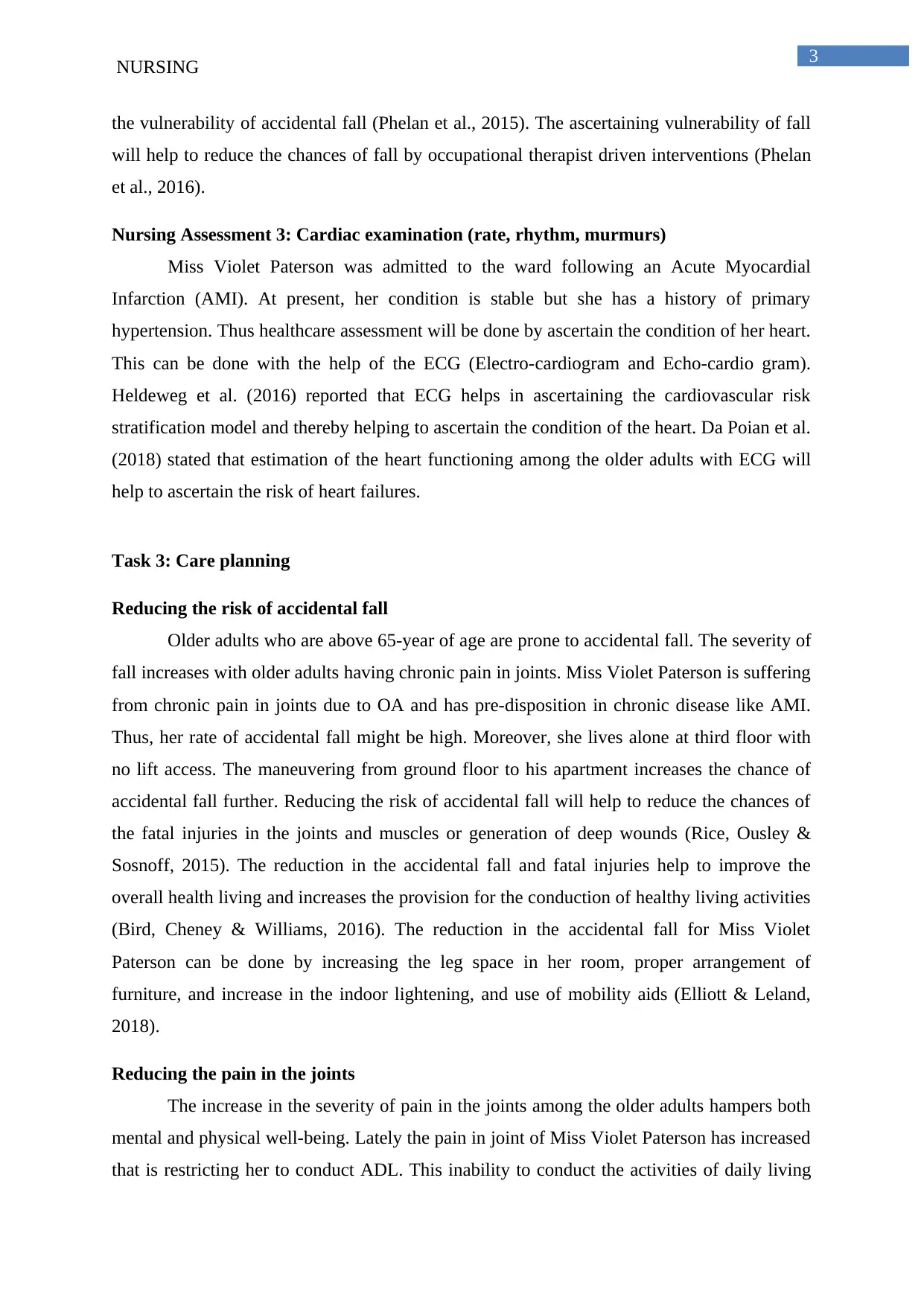
3
NURSING
the vulnerability of accidental fall (Phelan et al., 2015). The ascertaining vulnerability of fall
will help to reduce the chances of fall by occupational therapist driven interventions (Phelan
et al., 2016).
Nursing Assessment 3: Cardiac examination (rate, rhythm, murmurs)
Miss Violet Paterson was admitted to the ward following an Acute Myocardial
Infarction (AMI). At present, her condition is stable but she has a history of primary
hypertension. Thus healthcare assessment will be done by ascertain the condition of her heart.
This can be done with the help of the ECG (Electro-cardiogram and Echo-cardio gram).
Heldeweg et al. (2016) reported that ECG helps in ascertaining the cardiovascular risk
stratification model and thereby helping to ascertain the condition of the heart. Da Poian et al.
(2018) stated that estimation of the heart functioning among the older adults with ECG will
help to ascertain the risk of heart failures.
Task 3: Care planning
Reducing the risk of accidental fall
Older adults who are above 65-year of age are prone to accidental fall. The severity of
fall increases with older adults having chronic pain in joints. Miss Violet Paterson is suffering
from chronic pain in joints due to OA and has pre-disposition in chronic disease like AMI.
Thus, her rate of accidental fall might be high. Moreover, she lives alone at third floor with
no lift access. The maneuvering from ground floor to his apartment increases the chance of
accidental fall further. Reducing the risk of accidental fall will help to reduce the chances of
the fatal injuries in the joints and muscles or generation of deep wounds (Rice, Ousley &
Sosnoff, 2015). The reduction in the accidental fall and fatal injuries help to improve the
overall health living and increases the provision for the conduction of healthy living activities
(Bird, Cheney & Williams, 2016). The reduction in the accidental fall for Miss Violet
Paterson can be done by increasing the leg space in her room, proper arrangement of
furniture, and increase in the indoor lightening, and use of mobility aids (Elliott & Leland,
2018).
Reducing the pain in the joints
The increase in the severity of pain in the joints among the older adults hampers both
mental and physical well-being. Lately the pain in joint of Miss Violet Paterson has increased
that is restricting her to conduct ADL. This inability to conduct the activities of daily living
NURSING
the vulnerability of accidental fall (Phelan et al., 2015). The ascertaining vulnerability of fall
will help to reduce the chances of fall by occupational therapist driven interventions (Phelan
et al., 2016).
Nursing Assessment 3: Cardiac examination (rate, rhythm, murmurs)
Miss Violet Paterson was admitted to the ward following an Acute Myocardial
Infarction (AMI). At present, her condition is stable but she has a history of primary
hypertension. Thus healthcare assessment will be done by ascertain the condition of her heart.
This can be done with the help of the ECG (Electro-cardiogram and Echo-cardio gram).
Heldeweg et al. (2016) reported that ECG helps in ascertaining the cardiovascular risk
stratification model and thereby helping to ascertain the condition of the heart. Da Poian et al.
(2018) stated that estimation of the heart functioning among the older adults with ECG will
help to ascertain the risk of heart failures.
Task 3: Care planning
Reducing the risk of accidental fall
Older adults who are above 65-year of age are prone to accidental fall. The severity of
fall increases with older adults having chronic pain in joints. Miss Violet Paterson is suffering
from chronic pain in joints due to OA and has pre-disposition in chronic disease like AMI.
Thus, her rate of accidental fall might be high. Moreover, she lives alone at third floor with
no lift access. The maneuvering from ground floor to his apartment increases the chance of
accidental fall further. Reducing the risk of accidental fall will help to reduce the chances of
the fatal injuries in the joints and muscles or generation of deep wounds (Rice, Ousley &
Sosnoff, 2015). The reduction in the accidental fall and fatal injuries help to improve the
overall health living and increases the provision for the conduction of healthy living activities
(Bird, Cheney & Williams, 2016). The reduction in the accidental fall for Miss Violet
Paterson can be done by increasing the leg space in her room, proper arrangement of
furniture, and increase in the indoor lightening, and use of mobility aids (Elliott & Leland,
2018).
Reducing the pain in the joints
The increase in the severity of pain in the joints among the older adults hampers both
mental and physical well-being. Lately the pain in joint of Miss Violet Paterson has increased
that is restricting her to conduct ADL. This inability to conduct the activities of daily living
Paraphrase This Document
Need a fresh take? Get an instant paraphrase of this document with our AI Paraphraser

4
NURSING
reduces the level of self-confidence and self-esteem and thereby reducing the mental health
and well-being (Reid, Eccleston & Pillemer, 2015). The reduction in the level of pain in Miss
Violet Paterson can be done by effective amalgamation of the pharmacological intervention
and non-pharmacological interventions. The pharmacological intervention includes
administration of the painkillers or analgesic. However, the dosage of the painkiller or
analgesic must be regulated as per physicians’ advice depending on cardiac condition of Miss
Paterson and her risk of accidental fall generated as per the fall risk assessment (Boehmer,
2016). The non-pharmacological intervention for pain management will include use of the
music therapy. Effective use of the music as per the preference of the service users help to
reduce the conscious sensation of pain. The outcome of pain reduction will be measured with
the help of Visual Analog Pain Scales (Gallagher, Lagman & Rybicki, 2018).
Proper assistance in medication management
According to Irizarry et al. (2015) proper medication management and medication
adherence help to reduce the overall chance of mortality and morbidity among the older
adults who are suffering from chronic health diseases like cardiac disease. The adherence to
medication as per the proper dosage and on time can be done by educating the patient about
the disease progression and at the same time getting the patient accustomed with the self-
management skills of the disease.
Task 4: Patient education
The education of Miss Paterson can be done in the domain of medication management
in order to ensure proper medication management (Irizarry, Dabbs & Curran, 2015). The
Nursing and Midwifery Board of Australia (NMBA) (2018) highlights that educating and
engaging patients in the care plan helps to increase the therapy adherence. The education will
be done with a creative approach by the use of the power-point presentation (by use proper
images and information). Use of attractive information brochure and template or style of
procuring information help to grab the attention of the patient and at the same engages the
patient in the care plan. The education will also be given about the concept of healthy ageing
and how it can be promoted by abiding healthy lifestyle activities. A person-centered
approach that is culturally competent must be adopted while educating the patient about the
concept of healthy ageing (McMullen et al., 2015).
Task 5: Team care
NURSING
reduces the level of self-confidence and self-esteem and thereby reducing the mental health
and well-being (Reid, Eccleston & Pillemer, 2015). The reduction in the level of pain in Miss
Violet Paterson can be done by effective amalgamation of the pharmacological intervention
and non-pharmacological interventions. The pharmacological intervention includes
administration of the painkillers or analgesic. However, the dosage of the painkiller or
analgesic must be regulated as per physicians’ advice depending on cardiac condition of Miss
Paterson and her risk of accidental fall generated as per the fall risk assessment (Boehmer,
2016). The non-pharmacological intervention for pain management will include use of the
music therapy. Effective use of the music as per the preference of the service users help to
reduce the conscious sensation of pain. The outcome of pain reduction will be measured with
the help of Visual Analog Pain Scales (Gallagher, Lagman & Rybicki, 2018).
Proper assistance in medication management
According to Irizarry et al. (2015) proper medication management and medication
adherence help to reduce the overall chance of mortality and morbidity among the older
adults who are suffering from chronic health diseases like cardiac disease. The adherence to
medication as per the proper dosage and on time can be done by educating the patient about
the disease progression and at the same time getting the patient accustomed with the self-
management skills of the disease.
Task 4: Patient education
The education of Miss Paterson can be done in the domain of medication management
in order to ensure proper medication management (Irizarry, Dabbs & Curran, 2015). The
Nursing and Midwifery Board of Australia (NMBA) (2018) highlights that educating and
engaging patients in the care plan helps to increase the therapy adherence. The education will
be done with a creative approach by the use of the power-point presentation (by use proper
images and information). Use of attractive information brochure and template or style of
procuring information help to grab the attention of the patient and at the same engages the
patient in the care plan. The education will also be given about the concept of healthy ageing
and how it can be promoted by abiding healthy lifestyle activities. A person-centered
approach that is culturally competent must be adopted while educating the patient about the
concept of healthy ageing (McMullen et al., 2015).
Task 5: Team care
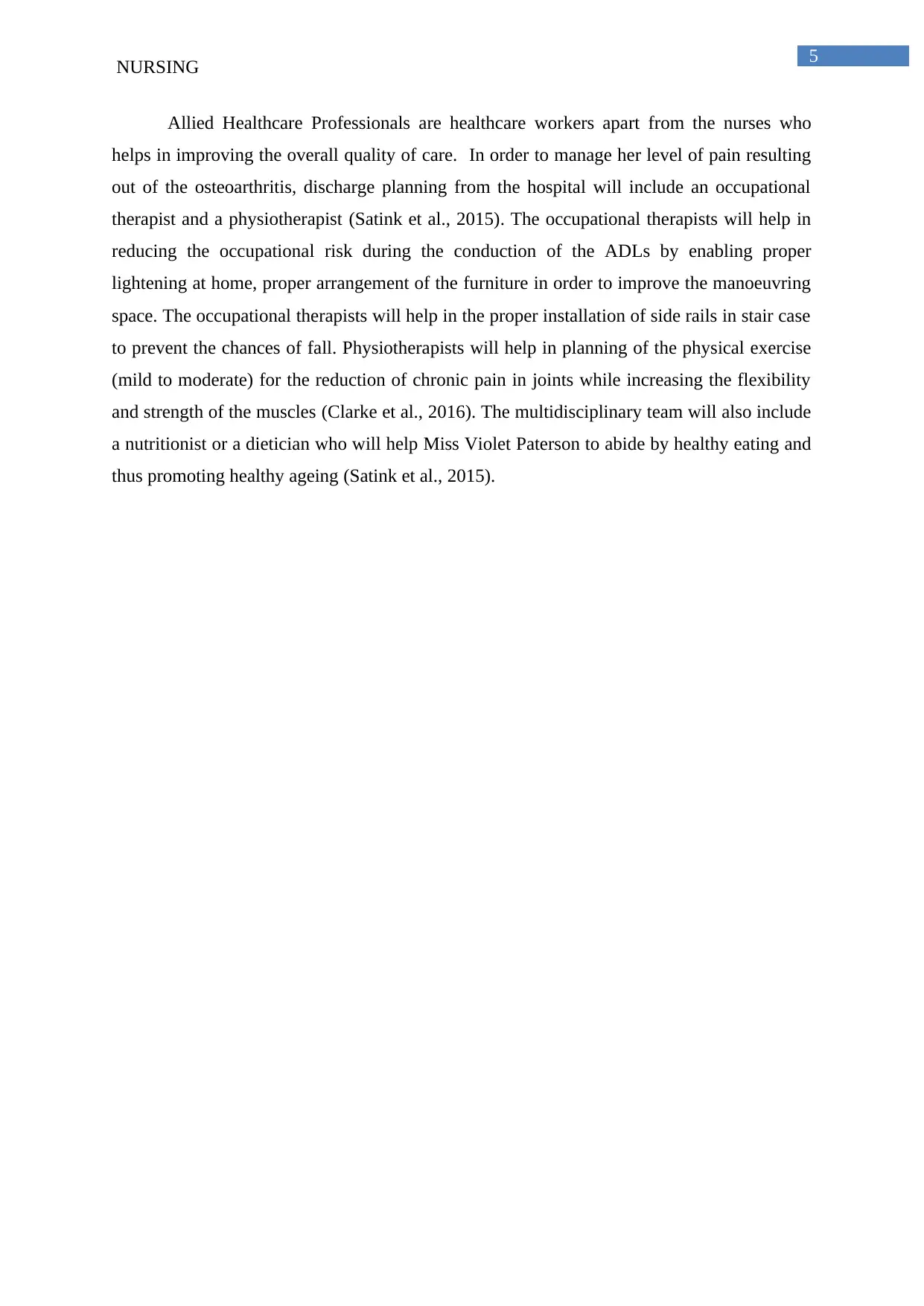
5
NURSING
Allied Healthcare Professionals are healthcare workers apart from the nurses who
helps in improving the overall quality of care. In order to manage her level of pain resulting
out of the osteoarthritis, discharge planning from the hospital will include an occupational
therapist and a physiotherapist (Satink et al., 2015). The occupational therapists will help in
reducing the occupational risk during the conduction of the ADLs by enabling proper
lightening at home, proper arrangement of the furniture in order to improve the manoeuvring
space. The occupational therapists will help in the proper installation of side rails in stair case
to prevent the chances of fall. Physiotherapists will help in planning of the physical exercise
(mild to moderate) for the reduction of chronic pain in joints while increasing the flexibility
and strength of the muscles (Clarke et al., 2016). The multidisciplinary team will also include
a nutritionist or a dietician who will help Miss Violet Paterson to abide by healthy eating and
thus promoting healthy ageing (Satink et al., 2015).
NURSING
Allied Healthcare Professionals are healthcare workers apart from the nurses who
helps in improving the overall quality of care. In order to manage her level of pain resulting
out of the osteoarthritis, discharge planning from the hospital will include an occupational
therapist and a physiotherapist (Satink et al., 2015). The occupational therapists will help in
reducing the occupational risk during the conduction of the ADLs by enabling proper
lightening at home, proper arrangement of the furniture in order to improve the manoeuvring
space. The occupational therapists will help in the proper installation of side rails in stair case
to prevent the chances of fall. Physiotherapists will help in planning of the physical exercise
(mild to moderate) for the reduction of chronic pain in joints while increasing the flexibility
and strength of the muscles (Clarke et al., 2016). The multidisciplinary team will also include
a nutritionist or a dietician who will help Miss Violet Paterson to abide by healthy eating and
thus promoting healthy ageing (Satink et al., 2015).
⊘ This is a preview!⊘
Do you want full access?
Subscribe today to unlock all pages.

Trusted by 1+ million students worldwide
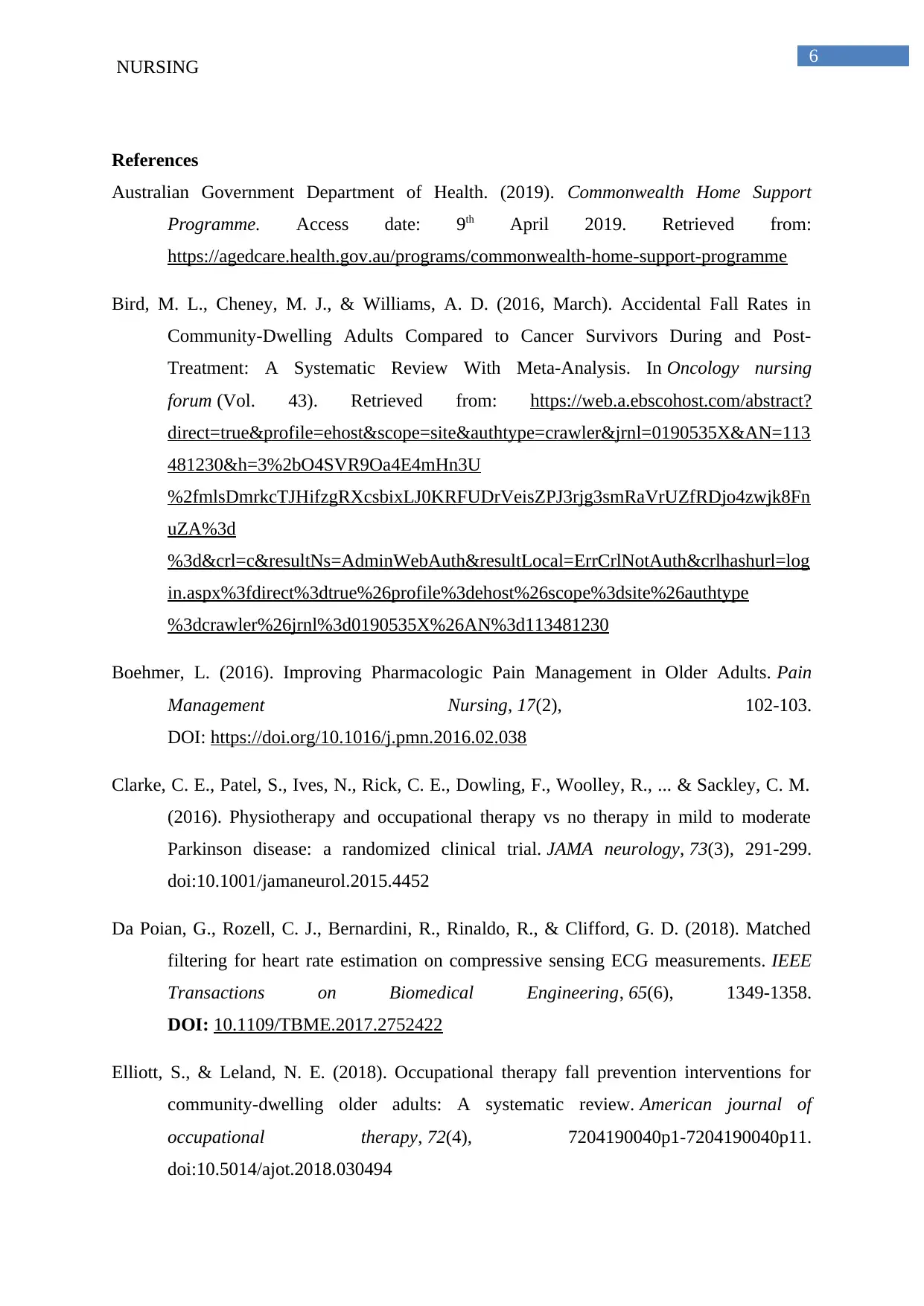
6
NURSING
References
Australian Government Department of Health. (2019). Commonwealth Home Support
Programme. Access date: 9th April 2019. Retrieved from:
https://agedcare.health.gov.au/programs/commonwealth-home-support-programme
Bird, M. L., Cheney, M. J., & Williams, A. D. (2016, March). Accidental Fall Rates in
Community-Dwelling Adults Compared to Cancer Survivors During and Post-
Treatment: A Systematic Review With Meta-Analysis. In Oncology nursing
forum (Vol. 43). Retrieved from: https://web.a.ebscohost.com/abstract?
direct=true&profile=ehost&scope=site&authtype=crawler&jrnl=0190535X&AN=113
481230&h=3%2bO4SVR9Oa4E4mHn3U
%2fmlsDmrkcTJHifzgRXcsbixLJ0KRFUDrVeisZPJ3rjg3smRaVrUZfRDjo4zwjk8Fn
uZA%3d
%3d&crl=c&resultNs=AdminWebAuth&resultLocal=ErrCrlNotAuth&crlhashurl=log
in.aspx%3fdirect%3dtrue%26profile%3dehost%26scope%3dsite%26authtype
%3dcrawler%26jrnl%3d0190535X%26AN%3d113481230
Boehmer, L. (2016). Improving Pharmacologic Pain Management in Older Adults. Pain
Management Nursing, 17(2), 102-103.
DOI: https://doi.org/10.1016/j.pmn.2016.02.038
Clarke, C. E., Patel, S., Ives, N., Rick, C. E., Dowling, F., Woolley, R., ... & Sackley, C. M.
(2016). Physiotherapy and occupational therapy vs no therapy in mild to moderate
Parkinson disease: a randomized clinical trial. JAMA neurology, 73(3), 291-299.
doi:10.1001/jamaneurol.2015.4452
Da Poian, G., Rozell, C. J., Bernardini, R., Rinaldo, R., & Clifford, G. D. (2018). Matched
filtering for heart rate estimation on compressive sensing ECG measurements. IEEE
Transactions on Biomedical Engineering, 65(6), 1349-1358.
DOI: 10.1109/TBME.2017.2752422
Elliott, S., & Leland, N. E. (2018). Occupational therapy fall prevention interventions for
community-dwelling older adults: A systematic review. American journal of
occupational therapy, 72(4), 7204190040p1-7204190040p11.
doi:10.5014/ajot.2018.030494
NURSING
References
Australian Government Department of Health. (2019). Commonwealth Home Support
Programme. Access date: 9th April 2019. Retrieved from:
https://agedcare.health.gov.au/programs/commonwealth-home-support-programme
Bird, M. L., Cheney, M. J., & Williams, A. D. (2016, March). Accidental Fall Rates in
Community-Dwelling Adults Compared to Cancer Survivors During and Post-
Treatment: A Systematic Review With Meta-Analysis. In Oncology nursing
forum (Vol. 43). Retrieved from: https://web.a.ebscohost.com/abstract?
direct=true&profile=ehost&scope=site&authtype=crawler&jrnl=0190535X&AN=113
481230&h=3%2bO4SVR9Oa4E4mHn3U
%2fmlsDmrkcTJHifzgRXcsbixLJ0KRFUDrVeisZPJ3rjg3smRaVrUZfRDjo4zwjk8Fn
uZA%3d
%3d&crl=c&resultNs=AdminWebAuth&resultLocal=ErrCrlNotAuth&crlhashurl=log
in.aspx%3fdirect%3dtrue%26profile%3dehost%26scope%3dsite%26authtype
%3dcrawler%26jrnl%3d0190535X%26AN%3d113481230
Boehmer, L. (2016). Improving Pharmacologic Pain Management in Older Adults. Pain
Management Nursing, 17(2), 102-103.
DOI: https://doi.org/10.1016/j.pmn.2016.02.038
Clarke, C. E., Patel, S., Ives, N., Rick, C. E., Dowling, F., Woolley, R., ... & Sackley, C. M.
(2016). Physiotherapy and occupational therapy vs no therapy in mild to moderate
Parkinson disease: a randomized clinical trial. JAMA neurology, 73(3), 291-299.
doi:10.1001/jamaneurol.2015.4452
Da Poian, G., Rozell, C. J., Bernardini, R., Rinaldo, R., & Clifford, G. D. (2018). Matched
filtering for heart rate estimation on compressive sensing ECG measurements. IEEE
Transactions on Biomedical Engineering, 65(6), 1349-1358.
DOI: 10.1109/TBME.2017.2752422
Elliott, S., & Leland, N. E. (2018). Occupational therapy fall prevention interventions for
community-dwelling older adults: A systematic review. American journal of
occupational therapy, 72(4), 7204190040p1-7204190040p11.
doi:10.5014/ajot.2018.030494
Paraphrase This Document
Need a fresh take? Get an instant paraphrase of this document with our AI Paraphraser

7
NURSING
Gallagher, L. M., Lagman, R., & Rybicki, L. (2018). Outcomes of music therapy
interventions on symptom management in palliative medicine patients. American
Journal of Hospice and Palliative Medicine®, 35(2), 250-257.
https://doi.org/10.1177/1049909117696723
Heldeweg, M. L. A., Liu, N., Koh, Z. X., Fook-Chong, S., Lye, W. K., Harms, M., & Ong,
M. E. H. (2016). A novel cardiovascular risk stratification model incorporating ECG
and heart rate variability for patients presenting to the emergency department with
chest pain. Critical Care, 20(1), 179. https://doi.org/10.1186/s13054-016-1367-5
Hodgson, K., Barton, L., Darling, M., Antao, V., Kim, F. A., & Monavvari, A. (2015). Pets'
impact on your patients' health: leveraging benefits and mitigating risk. J Am Board
Fam Med, 28(4), 526-534. https://doi.org/10.3122/jabfm.2015.04.140254
Irizarry, T., Dabbs, A. D., & Curran, C. R. (2015). Patient portals and patient engagement: a
state of the science review. Journal of medical Internet research, 17(6), e148.
doi:10.2196/jmir.4255
Katz, P., Lee, Y. C., Quebe, A., Sun, L., Patel, H., Gaich, C., ... & Michaud, K. (2018).
FRI0080 The role of pain in rheumatoid arthritis (RA) patients’ assessments of their
health. Annals of Rheumatoid Disease: http://dx.doi.org/10.1136/annrheumdis-2018-
eular.2740
McMullen, C. K., Safford, M. M., Bosworth, H. B., Phansalkar, S., Leong, A., Fagan, M.
B., ... & Brinkman, W. B. (2015). Patient-centered priorities for improving medication
management and adherence. Patient education and counseling, 98(1), 102-110.
https://doi.org/10.1016/j.pec.2014.09.015
Nursing and Midwifery Board of Australia (NMBA) (2018). Code of Professional Conduct.
Access date: 9th April 2019. Retrieved from:
https://www.nursingmidwiferyboard.gov.au/
Phelan, E. A., Aerts, S., Dowler, D., Eckstrom, E., & Casey, C. M. (2016). Adoption of
evidence-based fall prevention practices in primary care for older adults with a history
of falls. Frontiers in public health, 4, 190. https://doi.org/10.3389/fpubh.2016.00190
NURSING
Gallagher, L. M., Lagman, R., & Rybicki, L. (2018). Outcomes of music therapy
interventions on symptom management in palliative medicine patients. American
Journal of Hospice and Palliative Medicine®, 35(2), 250-257.
https://doi.org/10.1177/1049909117696723
Heldeweg, M. L. A., Liu, N., Koh, Z. X., Fook-Chong, S., Lye, W. K., Harms, M., & Ong,
M. E. H. (2016). A novel cardiovascular risk stratification model incorporating ECG
and heart rate variability for patients presenting to the emergency department with
chest pain. Critical Care, 20(1), 179. https://doi.org/10.1186/s13054-016-1367-5
Hodgson, K., Barton, L., Darling, M., Antao, V., Kim, F. A., & Monavvari, A. (2015). Pets'
impact on your patients' health: leveraging benefits and mitigating risk. J Am Board
Fam Med, 28(4), 526-534. https://doi.org/10.3122/jabfm.2015.04.140254
Irizarry, T., Dabbs, A. D., & Curran, C. R. (2015). Patient portals and patient engagement: a
state of the science review. Journal of medical Internet research, 17(6), e148.
doi:10.2196/jmir.4255
Katz, P., Lee, Y. C., Quebe, A., Sun, L., Patel, H., Gaich, C., ... & Michaud, K. (2018).
FRI0080 The role of pain in rheumatoid arthritis (RA) patients’ assessments of their
health. Annals of Rheumatoid Disease: http://dx.doi.org/10.1136/annrheumdis-2018-
eular.2740
McMullen, C. K., Safford, M. M., Bosworth, H. B., Phansalkar, S., Leong, A., Fagan, M.
B., ... & Brinkman, W. B. (2015). Patient-centered priorities for improving medication
management and adherence. Patient education and counseling, 98(1), 102-110.
https://doi.org/10.1016/j.pec.2014.09.015
Nursing and Midwifery Board of Australia (NMBA) (2018). Code of Professional Conduct.
Access date: 9th April 2019. Retrieved from:
https://www.nursingmidwiferyboard.gov.au/
Phelan, E. A., Aerts, S., Dowler, D., Eckstrom, E., & Casey, C. M. (2016). Adoption of
evidence-based fall prevention practices in primary care for older adults with a history
of falls. Frontiers in public health, 4, 190. https://doi.org/10.3389/fpubh.2016.00190
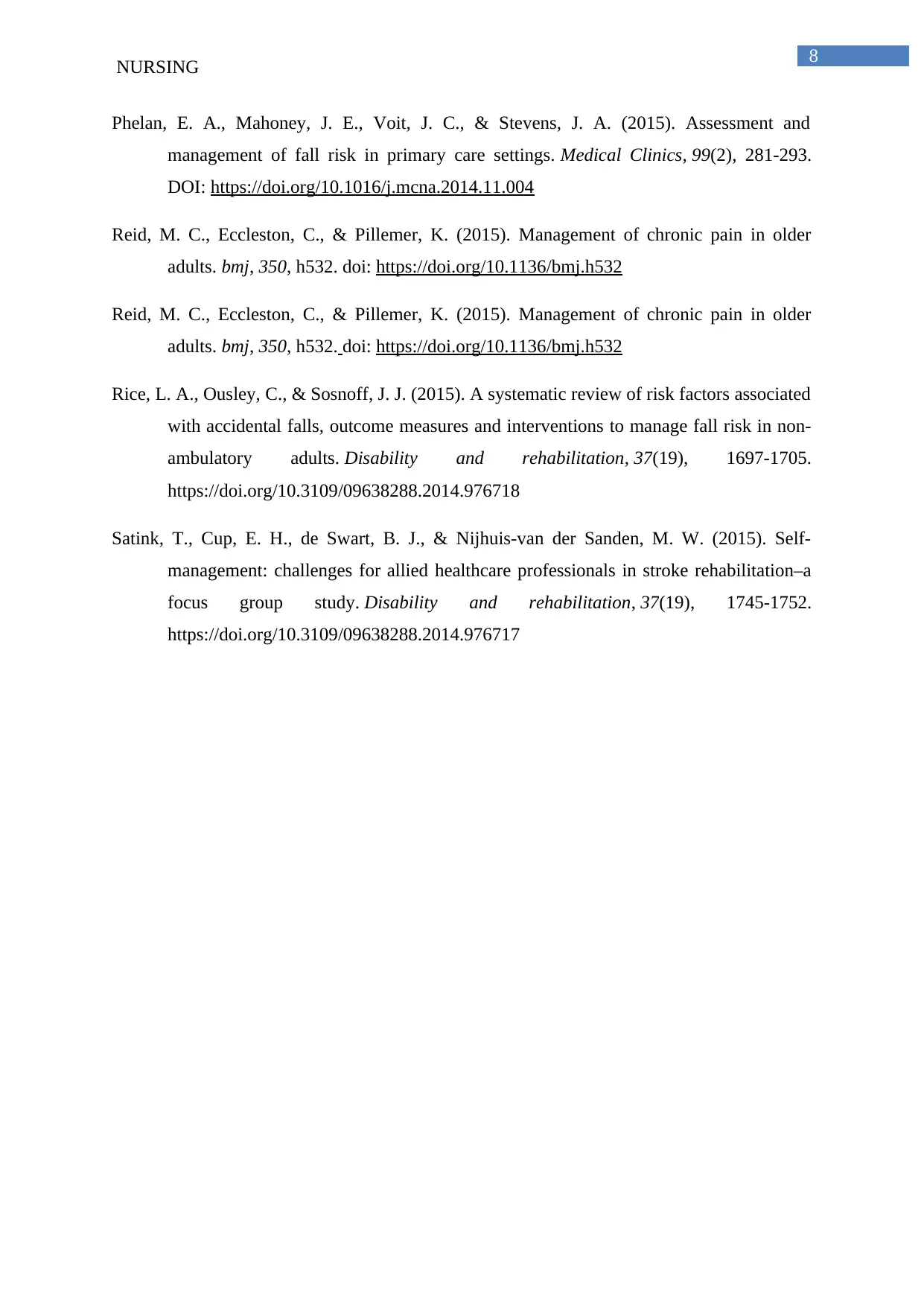
8
NURSING
Phelan, E. A., Mahoney, J. E., Voit, J. C., & Stevens, J. A. (2015). Assessment and
management of fall risk in primary care settings. Medical Clinics, 99(2), 281-293.
DOI: https://doi.org/10.1016/j.mcna.2014.11.004
Reid, M. C., Eccleston, C., & Pillemer, K. (2015). Management of chronic pain in older
adults. bmj, 350, h532. doi: https://doi.org/10.1136/bmj.h532
Reid, M. C., Eccleston, C., & Pillemer, K. (2015). Management of chronic pain in older
adults. bmj, 350, h532. doi: https://doi.org/10.1136/bmj.h532
Rice, L. A., Ousley, C., & Sosnoff, J. J. (2015). A systematic review of risk factors associated
with accidental falls, outcome measures and interventions to manage fall risk in non-
ambulatory adults. Disability and rehabilitation, 37(19), 1697-1705.
https://doi.org/10.3109/09638288.2014.976718
Satink, T., Cup, E. H., de Swart, B. J., & Nijhuis-van der Sanden, M. W. (2015). Self-
management: challenges for allied healthcare professionals in stroke rehabilitation–a
focus group study. Disability and rehabilitation, 37(19), 1745-1752.
https://doi.org/10.3109/09638288.2014.976717
NURSING
Phelan, E. A., Mahoney, J. E., Voit, J. C., & Stevens, J. A. (2015). Assessment and
management of fall risk in primary care settings. Medical Clinics, 99(2), 281-293.
DOI: https://doi.org/10.1016/j.mcna.2014.11.004
Reid, M. C., Eccleston, C., & Pillemer, K. (2015). Management of chronic pain in older
adults. bmj, 350, h532. doi: https://doi.org/10.1136/bmj.h532
Reid, M. C., Eccleston, C., & Pillemer, K. (2015). Management of chronic pain in older
adults. bmj, 350, h532. doi: https://doi.org/10.1136/bmj.h532
Rice, L. A., Ousley, C., & Sosnoff, J. J. (2015). A systematic review of risk factors associated
with accidental falls, outcome measures and interventions to manage fall risk in non-
ambulatory adults. Disability and rehabilitation, 37(19), 1697-1705.
https://doi.org/10.3109/09638288.2014.976718
Satink, T., Cup, E. H., de Swart, B. J., & Nijhuis-van der Sanden, M. W. (2015). Self-
management: challenges for allied healthcare professionals in stroke rehabilitation–a
focus group study. Disability and rehabilitation, 37(19), 1745-1752.
https://doi.org/10.3109/09638288.2014.976717
⊘ This is a preview!⊘
Do you want full access?
Subscribe today to unlock all pages.

Trusted by 1+ million students worldwide
1 out of 9
Related Documents
Your All-in-One AI-Powered Toolkit for Academic Success.
+13062052269
info@desklib.com
Available 24*7 on WhatsApp / Email
![[object Object]](/_next/static/media/star-bottom.7253800d.svg)
Unlock your academic potential
Copyright © 2020–2025 A2Z Services. All Rights Reserved. Developed and managed by ZUCOL.





